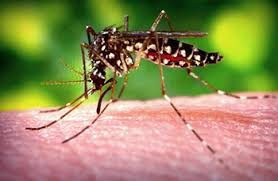DHHS → MeCDC → Disease Surveillance → Epidemiology → Vectorborne → Mosquito-borne Diseases
Mosquito-borne Diseases
What illnesses can I get from mosquitoes in Maine?
 Mosquitoes in Maine can carry viruses that can cause several illnesses. These include West Nile virus (WNV), Eastern Equine Encephalitis (EEE), and Jamestown Canyon virus (JCV). [1, 2, 3]
Mosquitoes in Maine can carry viruses that can cause several illnesses. These include West Nile virus (WNV), Eastern Equine Encephalitis (EEE), and Jamestown Canyon virus (JCV). [1, 2, 3]
How common are mosquito-borne illnesses in Maine?
- Mosquito-borne illnesses in humans are rarely acquired in Maine.
- You can find information on positive results in Maine on Maine CDC's Arboviral Surveillance webpage. [1]
What are the signs and symptoms of Eastern Equine Encephalitis (EEE), West Nile virus (WNV), and Jamestown Canyon infections in humans?
- EEE
- Some people infected with EEE will not show any signs or symptoms. [2, 4]
- Initial signs and symptoms include fever, chills, muscle and joint pain, and feeling uncomfortable. These typically last about 1-2 weeks. A full recovery can be made if the illness does not affect the brain or spinal tissue. [2, 5]
- About one third of people with EEE die from the infection. Of those that survive a EEE infection, about 1 out of every 2 people will have lasting neurologic (brain) complications. [2, 3]
- WNV
- Most people (8 out of 10) infected with WNV do not show any signs or symptoms. [6, 7]
- Initial signs and symptoms include fever, headache, muscle and joint pain, stomach illness, and rash. [6, 7, 8]
- Over 50% of WNV cases reported in the United States have neurologic (brain) complications. [9]
- About 1 out of every 10 people who develop severe illness will die. [6]
- Jamestown Canyon
- Initial signs and symptoms include fever, muscle aches, fatigue, dizziness, and headache. [10, 11]
- About half of the reported infections result in hospitalization. [11]
- It is not known how many people do not show signs or symptoms. [10]
- Illnesses caused by EEE, WNV, and Jamestown Canyon can be severe and cause encephalitis (brain swelling). Signs and symptoms in severe illness can include fever, headache, altered mental status, seizures, tremors, disorientation, vision loss, and coma. [2, 4, 6]
When do signs and symptoms of Eastern Equine Encephalitis (EEE) and West Nile virus (WNV) infection appear?
- Signs and symptoms of EEE usually begin 4 to 10 days after a bite from an infected mosquito. This can range from 3 to 14 days. [5]
- Signs and symptoms of WNV usually begin 2 to 6 days after a bite from an infected mosquito. This can range from 2 to 14 days. [8]
- Signs and symptoms of Jamestown Canyon can occur within 3 to 14 days after a bite from an infected mosquito. [12]
What other mosquito-borne illnesses are found around the world?
- Malaria, dengue, yellow fever, chikungunya, Zika, and Japanese encephalitis are illnesses spread by mosquitoes. [9, 13, 14, 15, 16, 17] These are not common in the United States.
- These are many other mosquito-borne illnesses found around the world.
- Several cases of travel-related mosquito-borne infections in Maine residents are reported each year. [1]
Are the mosquitoes that can carry the viruses that cause chikungunya, dengue, and Zika found in Maine?

- No. The species that can spread these illnesses are the Aedes aegypti and Aedes albopictus mosquitoes. Neither mosquito species is currently found in Maine. However, Maine is at the northern edge of the albopictus range. [18, 19]
Do all mosquitoes carry viruses that can cause illnesses?
- No. Only some types of mosquitoes in Maine can carry viruses that can cause illnesses. You cannot tell which mosquitoes are infected so it is best to practice prevention methods.
- The primary vector for EEE in Maine is the Culiseta melanura mosquitoes and the primary vector for WNV is the Culex pipiens mosquitoes. [2, 8, 19, 20]
Who is at risk for getting a mosquito-borne illness?
- Anyone who spends time outdoors is at risk if exposed to infected mosquitoes. This is especially true during dawn and dusk when EEE and WNV carrying mosquitoes are most active. [21, 22]
- Young children, people with weakened immune systems, and older adults are at greater risk of more severe illness and complications. [8, 20]
What should I know about mosquitoes and mosquito-borne diseases if I am traveling outside of Maine?
- You can get sick with a mosquito-borne illness in many parts of the country and world.
- There are vaccines available if you are traveling to an area with yellow fever or Japanese encephalitis. You can take anti-malarial medications if you are traveling to an area with malaria. [23, 24]
- You should be aware of the disease risks for areas to which you are traveling. If you are traveling within the United States, you can contact the state or local health department for more information. You can also visit U.S. CDC's Travelers' Health website to find information for countries outside of the United States.
- You should use bed nets, repellent, and wear protective clothing to prevent mosquito bites.
References
- Maine Center for Disease Control and Prevention. (2018). Arboviral surveillance. Retrieved from https://www.maine.gov/dhhs/mecdc/infectious-disease/epi/vector-borne/arboviral-surveillance.shtml
- Lindsey, N. P., Staples, J.E., & Fischer, M. (2018). Eastern Equine Encephalitis virus in the United States, 2003-2016. The American Journal of Tropical Medicine and Hygiene, 98(5), 1472-1477.
- Centers for Disease Control and Prevention. (2017). Eastern Equine Encephalitis: Epidemiology & geographic distribution. Retrieved from https://www.cdc.gov/easternequineencephalitis/tech/epi.html
- Maine Center for Disease Control and Prevention. (2015). Eastern Equine Encephalitis and West Nile virus – Maine, 2015. Retrieved from https://www.maine.gov/dhhs/mecdc/infectious-disease/epi/vector-borne/documents/MBD-Maine-2015.pdf
- Centers for Disease Control and Prevention. (2018). Eastern Equine Encephalitis. Retrieved from https://www.cdc.gov/easternequineencephalitis/index.html
- Centers for Disease Control and Prevention. (2018). West Nile virus. Retrieved from https://www.cdc.gov/westnile/index.html
- Patel, C.B., Trikamji, B.V., Mathisen, G.E., & Mishra, S.K. (2018). Southern California neuroinvasive West Nile virus case series. Neurological Sciences, 39(2), 251-257. doi:
10.1007/s10072-017-3164-6 - Heymann, D.L. (2015). West Nile virus disease. Control of Communicable Diseases Manual, 20th Edition, 675-679.
- Burakoff, A., Lehman J., Fischer, M., Staples, J.E., & Lindsey, N. P. (2018). West Nile virus and other nationally notifiable arboviral diseases – United Sates, 2016. Morbidity and Mortality Weekly Report 67(1), 13-17.
- Pastula, D.M., Smith, D.E., Beckham, J.D., & Tyler, K.L. (2016). Four emerging arboviral diseases in North America: Jamestown Canyon, Powassan, chikungunya, and Zika virus diseases. Journal of NeuroVirologyl, 22(3), 257-260. doi: 10.1007/s13365-016-0428-5
- Pastula, D.M., Hoang Johnson, D.K., White, J.L., Dupuis, A.P.II., Fischer, M., & Staples, J.E. (2015). Jamestown Canyon virus disease in the United States – 2000-2013. The American Journal of Tropical Medicine and Hygiene, 93(20), 384-389. doi: 10.4269/ajtmh.15-0196
- Heymann, D.L. (2015). West Nile virus disease. Control of Communicable Diseases Manual, 20th Edition, 36-40.
- Salam, N., Mustafa, S., Hafiz, A., Chaudhary, A.A., Deeba, F., & Parveen, S. (2018). Global prevalence and distribution of coinfection of malaria, dengue and chickungunya: A systematic review. BMC Public Health, 18(1), 710. doi: 10.1186/s12889-018-5626-z
- Taylor, K.G., & Peterson, K.E. (2014). Innate immune response to La Crosse virus infection. Journal of NeuroVirology, 20, 150-156. doi: 10.1007/s13365-013-0186-6
- Shearer, F.M., Longbottom, J., Browne, A.J., Pigott, D.M., Brady, O.J., Kraemer, M.U.G.,...Goulding, N. (2018). Existing and potential infection risk zones of yellow fever worldwide: A modeling analysis. The Lancet Global Health, 6(3), e270-e278. doi: 10.1016/S2214-109X(18)30024-X
- Mittal, R., Nguyen, D., Debs, L.H., Patel, A.M., Liu, G. Jhaveri, V.M.,...Liu, X.Z. (2017). Zika virus: An emerging global health threat. Frontiers in Cellular and Infection Microbiology, 7(486), 1-19. doi: 10.3389/fcimb.2017.00486
- Caldwell, J.P., Chen, L.H., & Hamer, D.H. (2018). Evolving epidemiology of Japanese encephalitis: Implications for vaccination. Current Infectious Disease Reports, 20(9), 1-13. doi: 10.1007/s11908-018-0635-8
- Maine Center for Disease Control and Prevention. (2016). Arboviral Illness Prevention, Control and Response Plan for Maine Communities. Retrieved from https://www.maine.gov/dhhs/mecdc/infectious-disease/epi/vector-borne/documents/2016-Arbo-Plan.pdf
- Hahn, M. B., Eisen, R. J., Eisen, L., Boegler, K.A., Moore, C.G., McAllister, J., Savage, H.M., Mutebi, J. (2016). Reported Distribution of Aedes (Stegomyia) aegypti and Aedes (Stegomyia) albopictus in the United States, 1995-2016 (Diptera: Culicidae). Journal of Medical Entomology 53(5), 1169-1175. doi: 10.1093/jme/tjx088
- Gaensbauer, J.T., Lindsey, N.P., Messacar, k., Staples, J.E., & Fischer, M. (2014). Neuroinvasive Arboviral Disease in the Unites States: 2003 to 2012. Pediatrics, 134, e642-e650. doi: 10.1542/peds.2014-0498.
- Bosak, P.J., Reed, L.M., & Crans, W.J. (2001). Habitat preference of host-seeking Coquillettidia perturbans (Walker) in relation to birds and eastern equine encephalomyelitis virus in New Jersey. Journal of Vector Ecology, 26(1), 103-109.
- Davis, L.E., Beckham, J.D., & Tyler, K.L. (2008). North American encephalitic arboviruses. Neurologic Clinics, 26(3), 727-757. doi: 10.1016/j.ncl.2008.03.012
- Bonin, C.R.B., Fernandes, G.C., Dos Santos, R.W., & Lobosco, M. (2018). A qualitatively validated mathematical-computational model of the immune response to the yellow fever vaccine. BMC Immunology, 19(1), 1-17. doi: 10.1186/s12865-018-0252-1
- Chen, H-L., Chang, J-K., & Tang, R-B. (2015). Current recommendations for the Japanese encephalitis vaccine. Journal of the Chinese Medical Association, 78(5), 271-275. doi: 10.1016/j.jcma.2014.12.009

